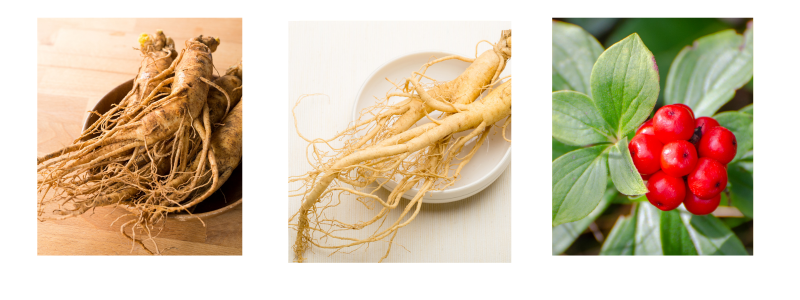Unveiled The Secrets: White Ginseng vs. Red Ginseng
Sep 4th 2023
The white and red ginseng are the most popular out of the ginsengs, though there are several more ginsengs to choose from. In today's blog we will be only talking about Red and White ginseng only.
Though in case you are wondering what other ginsengs there are here is a short list with descriptions is at the bottom of this page.
White ginseng and red ginseng are two different forms of ginseng, a popular herbal remedy known for its potential health benefits.

The primary difference between them lies in how they are processed and prepared:
White Ginseng:
Processing: White ginseng is produced by air-drying ginseng roots after they are harvested. The drying process is typically done naturally under the sun or through gentle heating methods.
Color: The roots of white ginseng retain their natural color, which is a pale beige or yellowish-white.
Active Compounds: White ginseng contains a slightly different profile of active compounds compared to red ginseng. It tends to have higher levels of certain ginsenosides, which are believed to be responsible for many of ginseng's health benefits.
Taste and Smell: White ginseng has a milder taste and odor compared to red ginseng.
Red Ginseng:
Processing: Red ginseng is created through a more complex and time-consuming process. After harvesting, ginseng roots are steamed at high temperatures (usually around 100°C or 212°F) before being dried. This steaming and drying process turns the roots a reddish-brown color.
Color: As the name suggests, red ginseng has a distinctive reddish-brown appearance.
Active Compounds: The steaming and drying process of red ginseng alters the chemical composition of the root. It can increase the levels of specific ginsenosides and other bioactive compounds, potentially enhancing its therapeutic effects.
Taste and Smell: Red ginseng has a stronger and more bitter taste compared to white ginseng.
Usage and Benefits: Both white and red ginseng are used in traditional herbal medicine and as dietary supplements for various purposes, including:
Boosting energy and reducing fatigue Enhancing cognitive function
Supporting the immune system Improving stress management
Enhancing endurance and physical performance
The choice between white and red ginseng often depends on individual preferences and specific health goals. Some people may prefer the milder taste and different active compound profile of white ginseng, while others may opt for red ginseng's potentially enhanced benefits due to its processing method. It's essential to note that the scientific evidence regarding the specific health benefits of ginseng, whether white or red, is still being studied, and individual responses can vary.

There are several different types of ginseng, each originating from various regions around the world. Here are the names of some of the most well-known types of ginseng:
- Asian Ginseng (Panax Ginseng): This is one of the most widely recognized and studied types of ginseng. It's native to China and Korea and is often referred to as Korean ginseng or Chinese ginseng. Asian ginseng is further categorized into different types based on its growth and processing, including:
- White Ginseng: Dried ginseng root that has not been steamed.
- Red Ginseng: Ginseng root that has been steamed and then dried, resulting in a reddish-brown color.
- American Ginseng (Panax quinquefolius): Native to North America, American ginseng is distinct from Asian ginseng and is known for its potential health benefits. It is often used in herbal remedies and supplements.
- Siberian Ginseng (Eleutherococcus senticosus): Also known as Eleuthero, Siberian ginseng is not a true ginseng but is often included in discussions due to its similar-sounding name. It is native to Siberia and is used for its adaptogenic properties.
- Japanese Ginseng (Panax japonicus): This type of ginseng is found in Japan and has similarities to Asian ginseng in terms of its potential benefits.
- Indian Ginseng (Withania somnifera): Also known as Ashwagandha, this herb is not a true ginseng but is sometimes referred to as Indian ginseng due to its adaptogenic properties. It is widely used in traditional Ayurvedic medicine.
- Brazilian Ginseng (Pfaffia paniculata): Known as Suma or Brazilian ginseng, this plant is native to the Amazon rainforest. It is considered an adaptogen and has been used in traditional herbal medicine.
- Peruvian Ginseng (Lepidium meyenii): Also known as Maca, this root vegetable is native to the high-altitude regions of the Andes in Peru. It is often referred to as Peruvian ginseng due to its adaptogenic properties.
- Tienchi Ginseng (Panax notoginseng): Native to China, Tienchi ginseng is known for its potential cardiovascular benefits and is used in traditional Chinese medicine.
- Himalayan Ginseng (Panax pseudoginseng): Found in the Himalayan region, this type of ginseng is used for its potential medicinal properties.
It's important to note that while ginseng is widely used in traditional and herbal medicine, the specific benefits and effects can vary between the different types of ginseng. Additionally, individual responses to ginseng may vary, and it's advisable to consult with a healthcare provider before using ginseng or any herbal remedy, especially if you have underlying medical conditions or are taking medications.Before using ginseng or any herbal supplement, it's advisable to consult with a healthcare provider, especially if you have underlying medical conditions or are taking medications, to ensure it is safe and appropriate for your specific needs.


